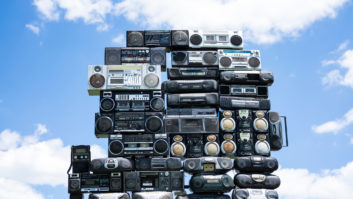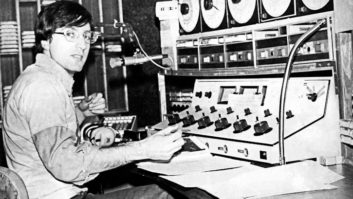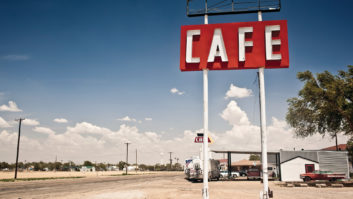Time was when radio stations were the only audio restaurants in town, and they served up all you could eat. Whether you liked country, classical or classic rock, you knew where to go to get an earful.
Today, however, new venues keep popping up, and they each have a differentiated format to present to customers. They are usually pretty small venues that prefer to serve only a few customers, but with high style and quality — and with narrowly defined cuisine, but lots of choices on the menu. Some even allow you to customize your order to your own tastes.
So how does the old radio diner measure up to these new sonic bistros?
The other LCD
The music formats of most local commercial radio stations are by design limited to a tightly controlled set and sequence of songs.
In this way, they really do follow the fast-food model. They may be locally owned and operated, but they brand themselves by association with a nationally consistent flavor, under the banner of a format name — a franchise.
While in television the LCD is a good thing, driving down the prices for HDTV displays, in radio we are facing the other (or original) LCD — the Lowest Common Denominator — as a descriptor of most traditional radio formats. While this used to be a formula for maximizing listeners, it may not be as effective in this era of expanded choice.
For now, radio’s greater service availability continues to keep its popularity high, but as new formats become increasingly available themselves, will the LCD label become a greater liability?
Some would say that there will always be a market for an LCD service, claiming that by statistical definition, it appeals to the largest single pool of listeners. But that appeal will only translate into actual usage (i.e., listening) if there is no better alternative available to each listener. As more options abound, more listeners may choose something more suitable, and few may remain satisfied with only the LCD.
Just like fast food, it’s not that it’s badly prepared, but the menu is certainly limited, and rarely changes. If other choices are readily available and obvious, there’s plenty of pent-up demand to drive customers away from the old standby.
Another LCD analogy is price, of course. It’s one of the appeals of fast food, and of local radio, too. Radio already occupies this lowest level of the audio food chain, which may hold some appeal to advertisers, but is not the most advantageous position to build upon for future growth and the thwarting of new competition. It’s also a place from which there’s only one direction to move, and that’s never a comfortable spot.
Coping skills
There are several ways that radio can avoid being stuck in the LCD corner forever.
To continue the food-emporium metaphor, consolidating local chains can be helpful. This is something that both restaurateurs and radio stations have already done in recent years. Optimizing multiple outlets to appeal to different customer cohorts is a smart strategy, but there’s a risk of spreading resources too thinly and ruining everything, so proper balance must be maintained.
Another approach that has proven successful recently in the food industry involves operating multiple restaurants from a single kitchen (and single loading dock, administrative office, etc.). For example, an increasingly popular approach combines casual dining downstairs with fine dining upstairs, plus a carry out window, all under a single-branded venue, but with readily identifiable variations.
The radio equivalent is a single station with IBOC multicast and/or Webcast streams that all serve up the same general format, but with upscale and downscale variants.
A further new trend in the restaurant biz is catering to “foodies” with club memberships, newsletters, recipes, kitchen tours, cooking classes and other higher levels of involvement for their most motivated customers.
Radio can do the same with online frequent listener clubs, chats, DJ cams, concert calendars, podcasts, online customized-stream players, music storefronts (i.e., links for listeners to purchase downloads of songs featured on air), and other features building upon the station’s format and brand, as some have already begun to do.
Sometimes you feel like a nut …
The fact that listeners sometimes turn to their own libraries for content is to be expected. That’s been the case since radio and the phonograph coexisted. Sometimes a listener may be in the mood for radio content, sometimes for stored content — simple as that.
So let’s acknowledge this and move on. Rather than trying to deny it, why not embrace it? In that regard, radio can act as an agent to help listeners discover and navigate an increasingly complex media landscape.
For example, while it may seem counterintuitive to make it easier for listeners to obtain downloaded content that keeps them from listening to the radio, recognize that listeners are going to download music anyway.
Why not make your station their online music store, at least for some of their purchases? It builds brand loyalty and front-of-mind value when considering music of your station’s format.
(Why would a restaurant give away their recipes? Because people are not going to eat out every night — they’re probably going to cook at home most of the time. So why not have them thinking about your restaurant while doing it?)
Moreover, this contextual shift to the local content library may also make listeners retrospectively realize the value of your station, as they hear the song by itself on their player rather than surrounded by other well-chosen music, relevant information and assorted continuity on the air — just as the person cooking the restaurant’s recipe at home probably realizes how much better the dish seemed at the restaurant.
As my teenage soon once told me, sometimes it’s more exciting to hear a song on the radio than from your own player because you know so many other people are listening to it along with you.
One way or another, radio needs to serve up a wider variety of content, across a broader range of platforms and with a richer set of associated materials than it has in the past. It also needs to tap deeper into its communities of interest (both geographic and formatic) to show its true value.
Remember that radio is what you do, not who you are. Who you are, really, is a ubiquitous purveyor of information and entertainment, and AM or FM radio broadcasting is just one method of its delivery today.
Just as chefs have realized that there can be numerous contexts in which they present their wares — from white tablecloths and candlelight to the frozen food case at the supermarket — radio can apply similar thinking to avoid a permanent sentence to life in the fast-food lane.












